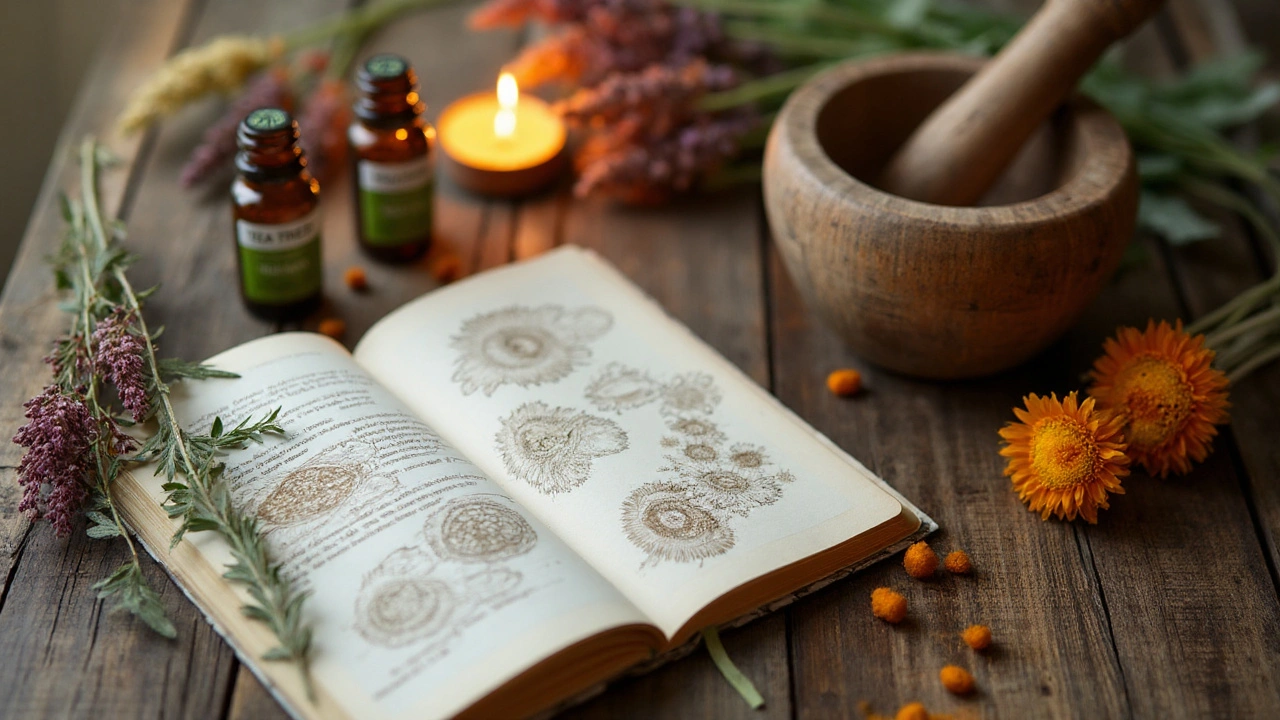Yeast infection of the skin is a superficial fungal condition caused primarily by Candida albicans. It shows up as red, itchy patches, sometimes with a silvery‑white ring. While prescription creams work, many people seek a natural yeast infection skin cure that avoids chemicals and supports the skin microbiome.
Quick Take
- Identify the infection: redness, itching, and a rash that worsens in warm, moist areas.
- Top essential oils: tea tree, lavender, oregano, neem, clove.
- Key herbs: neem leaves, garlic, apple cider vinegar, probiotic‑rich foods.
- DIY recipe steps: dilute oils, apply twice daily, monitor for irritation.
- Safety: always patch‑test, avoid broken skin, consult a clinician if symptoms persist.
Understanding Skin Yeast Infections
Candida overgrowth thrives in damp environments-think skin folds, hot weather, or after heavy sweating. Factors such as antibiotics, diabetes, or a weakened immune system tip the balance, letting the fungus multiply. The skin’s natural barrier-its microbiome-helps keep Candida in check; when that barrier is disrupted, a rash can appear within days.
Typical signs include:
- Red or pink patches with defined edges.
- Itching or burning sensation.
- White, cheese‑like scaling.
- Occasional small pustules.
Recognizing these early can prevent spreading to larger areas or deeper layers.
How Essential Oils Fight Fungi
Essential oils contain concentrated phytochemicals that disrupt fungal cell walls, inhibit spore formation, and reduce inflammation. Below are the most studied oils, each introduced with microdata for easy reference.
Tea Tree Oil is a broad‑spectrum antifungal extracted from Melaleuca alternifolia. Its main component, terpinen‑4‑ol, has proven activity against Candida albicans in vitro, reducing colony‑forming units by up to 90% within 30 minutes.
Lavender Oil comes from Lavandula angustifolia. Linalool and linalyl acetate work synergistically to calm skin while exhibiting modest antifungal effects, making it ideal for sensitive areas.
Oregano Oil is derived from Origanum vulgare. Carvacrol, its primary active, is one of the strongest natural antifungals, often outperforming synthetic agents in laboratory tests.
Neem Oil originates from the seeds of Azadirachta indica. It contains azadirachtin and nimbidin, which interfere with fungal enzyme pathways, and also soothe irritated skin.
Clove Oil is extracted from Syzygium aromaticum. Eugenol, its star compound, disrupts fungal membranes and offers powerful analgesic properties for itchy rashes.
Top Herbs and Home Ingredients
Beyond oils, several herbs and pantry items act as natural antifungals. They can be used as rinses, poultices, or dietary boosters for the skin’s microbiome.
- Garlic - allicin kills Candida spores; crush and apply a thin paste.
- Apple Cider Vinegar - acetic acid balances skin pH; dilute 1:4 with water for a soothing wash.
- Neem Leaves - make a decoction and cool before applying as a compress.
- Probiotic‑rich foods - yogurt, kefir, and kimchi feed beneficial bacteria that outcompete yeast.

DIY Treatment Recipes
All recipes assume a 5% dilution for topical use, which is safe for most adults. Adjust based on skin sensitivity.
- Tea Tree & Lavender Spot Treatment
- 5drops Tea Tree Oil
- 5drops Lavender Oil
- 30ml carrier oil (e.g., jojoba or sweet almond)
Mix in a dark glass bottle, shake, and apply a thin layer to clean skin twice daily.
- Oregano‑Neem Antifungal Cream
- 3drops Oregano Oil
- 3drops Neem Oil
- 30ml coconut oil (solid at room temperature)
Melt coconut oil, stir in the essential oils, let cool, and store in a small jar. Use at night.
- Clove‑Garlic Paste
- 1clove fresh garlic, minced
- 2drops Clove Oil
- 1teaspoon raw honey (optional for soothing)
Combine, let sit 5minutes, then apply to rash for 15minutes before rinsing. Use once daily.
- Apple Cider Vinegar Rinse
- 1part raw apple cider vinegar
- 4parts cool water
After showering, pour over affected area, leave for 2minutes, then pat dry. Do not use on broken skin.
Safety & Precautions
Natural doesn’t mean risk‑free. Follow these guidelines:
- Patch test: Apply a diluted drop to the inner forearm; wait 24hours for any reaction.
- Avoid open wounds: Essential oils can cause burning if the skin barrier is broken.
- Pregnancy & children: Keep concentrations below 1% for infants; consult a health professional for pregnant users.
- Storage: Keep oils in amber bottles, away from sunlight and heat.
If a rash worsens after 7‑10days, seek medical advice-persistent Candida may need prescription therapy.
Related Topics
Understanding how these natural agents fit into a broader health picture can boost results. Consider exploring:
- Skin microbiome balance and probiotic supplements.
- Dietary strategies to lower systemic yeast overgrowth.
- Environmental factors like humidity and clothing that influence fungal growth.
These adjacent subjects reinforce the effectiveness of the topical remedies outlined above.
| Oil | Key Antifungal Compound | Typical % Dilution | Skin Sensitivity Rating |
|---|---|---|---|
| Tea Tree | Terpinen‑4‑ol | 5% | Low |
| Lavender | Linalool & Linalyl acetate | 5% | Very Low |
| Oregano | Carvacrol | 2-3% | Medium |
| Neem | Azadirachtin | 5% | Low |
| Clove | Eugenol | 1-2% | Medium‑High |
Next Steps & Troubleshooting
If you’ve tried the above recipes and still see signs of infection, try these adjustments:
- Increase frequency: Apply every 4hours instead of twice daily.
- Combine modalities: Use a vinegar rinse in the morning and an oil cream at night.
- Dietary reset: Cut added sugars and refined carbs for two weeks to starve Candida from the inside.
- Seek professional care: Persistent or spreading rash may signal a deeper infection requiring oral antifungals.

Frequently Asked Questions
Can I use essential oils without a carrier?
No. Undiluted oils are too potent and can burn the skin. Always mix with a carrier like jojoba, coconut, or almond oil before applying.
How long does it take to see results?
Most people notice reduced itching and redness within 3-5days. Full clearance typically occurs after 2weeks of consistent use.
Are there any oils I should avoid?
Avoid citrus oils (like lemon or orange) on fungal infections-they can increase photosensitivity and may not penetrate the skin well.
Is it safe to use these treatments on children?
For kids older than 2years, keep dilution at 1% (about 1drop essential oil per 10ml carrier). Always perform a patch test first.
Can diet affect skin yeast infections?
Yes. High‑sugar and refined‑carb diets feed Candida. Reducing these foods and adding probiotic‑rich foods helps keep the fungus in check.
What if I experience a burning sensation?
Stop the treatment, rinse with cool water, and apply a soothing aloe or plain coconut oil. If burning persists, consult a healthcare professional.
Do essential oils work on other fungal conditions?
Many of the oils listed also help with athlete’s foot, nail fungus, and ringworm, though formulations may differ based on the infection site.

Been using the tea tree + lavender mix for my inner thigh rash and it’s been a game changer. No more itching by day 3. Just make sure you dilute it right - I learned the hard way with undiluted oil. Ouch.
The data in this post is superficial. Carvacrol’s MIC against Candida albicans is around 0.03% in vitro, but topical bioavailability is negligible without penetration enhancers. You’re giving people false hope with DIY solutions.
Man, I love this kind of real, grounded wisdom. We’ve been so conditioned to reach for prescriptions when our bodies are screaming for balance. Nature’s got the blueprint - we just gotta listen. I’ve seen folks with chronic yeast issues turn their lives around with neem baths, probiotic yogurt, and cutting out sugar. It’s not magic, it’s microbiome medicine. And honestly? The fact that we’re even talking about this instead of just popping pills? That’s progress. We’re waking up.
I appreciate the detailed breakdown. I’ve had recurrent rashes after antibiotics and found the ACV rinse helpful, but I always check with my dermatologist before trying anything new. Safety first.
Essential oils work? Sure. And the moon controls the tides. Next you’ll tell me garlic cures cancer. This is just placebo with a fancy bottle and a yoga retreat vibe
I’ve been using the oregano-neem cream for about two weeks now, and I have to say - it’s been the most gentle yet effective thing I’ve tried. I have sensitive skin and usually flare up with anything strong, but this one? Just calm. I mix it with shea butter sometimes for extra moisture. Also, the part about avoiding citrus oils? Big yes. I learned that the hard way after using lemon oil on a sunburn. Not fun.
They don’t want you to know this but the FDA and Big Pharma are suppressing natural cures because essential oils don’t have patents. Tea tree oil? 90% efficacy? That’s why they push expensive creams - profit. They even banned neem in the EU for ‘safety reasons’ - right after the pharmaceutical lobby got involved. Wake up. This post is truth serum for your skin.
While the anecdotal evidence presented is compelling, the absence of randomized controlled trials undermines the clinical validity of these recommendations. The concentration of terpinen-4-ol in commercial tea tree oil varies widely, rendering the 90% reduction claim statistically unreliable without standardized sourcing. Furthermore, the term ‘skin microbiome’ is often misapplied in popular media without reference to metagenomic data. I would caution against substituting evidence-based therapeutics with unregulated botanical preparations.
i tried the clove-garlic paste and it burned so bad i cried. i think i did it wrong. maybe i used too much clove oil? or was the garlic too fresh? i dont know. but i stopped. now i just use coconut oil. its not magic but it dont burn.
Ugh, I’ve been dealing with this for YEARS. And now I’m supposed to believe a few drops of oil and some yogurt are going to fix it? I’ve tried EVERYTHING. I even did a 30-day sugar detox. I’m exhausted. This feels like another ‘natural fix’ scam to make people feel better while they’re still suffering.
This is such a beautifully curated guide - the way you’ve woven together phytochemistry, traditional wisdom, and practical application is genuinely artful. I especially appreciated the breakdown of dilution ratios and the emphasis on the microbiome as a living ecosystem rather than a battleground. As someone who’s spent years navigating chronic skin issues, I find this approach not just therapeutic, but deeply respectful of the body’s innate intelligence. The table comparing oils? Chef’s kiss. I’ve printed this out and taped it to my bathroom mirror. Thank you.
Hey so I tried the ACV rinse but my skin got red and raw - did you mean to say 1:1 or 1:4? Also can I use it on my butt crack? My friend said it worked for her but I don’t wanna burn myself again lol
OMG YES 🙌 I’ve been using the tea tree + lavender blend and my skin looks like a newborn’s 😭✨ I even posted a pic on IG and got 200 DMs asking for the recipe. You’re a legend. Also, PLEASE tell me you use amber bottles - if you’re storing oils in clear glass, you’re basically pouring money down the drain 💸🌿 #NaturalSkinGlow #EssentialOilQueen